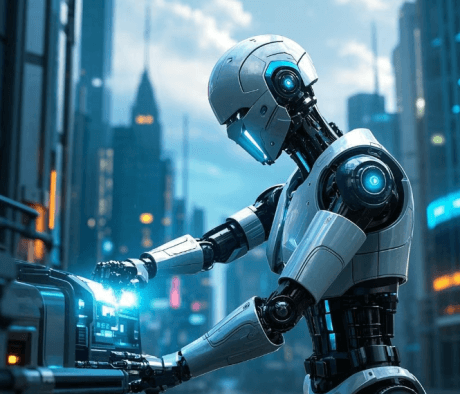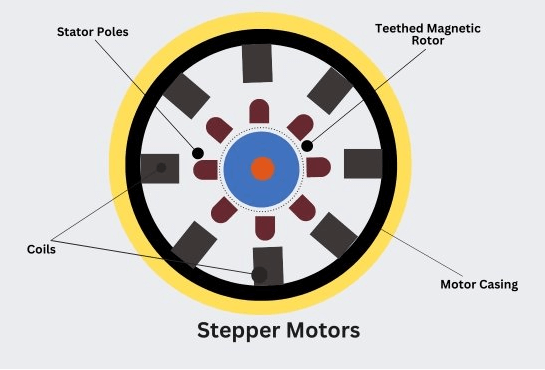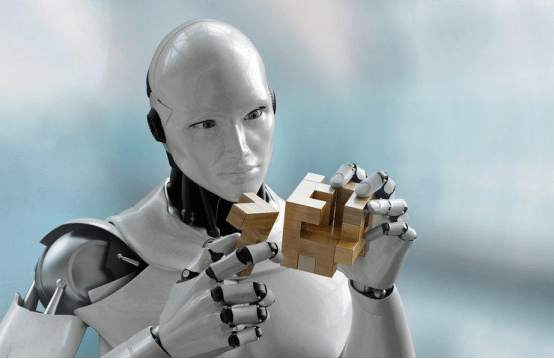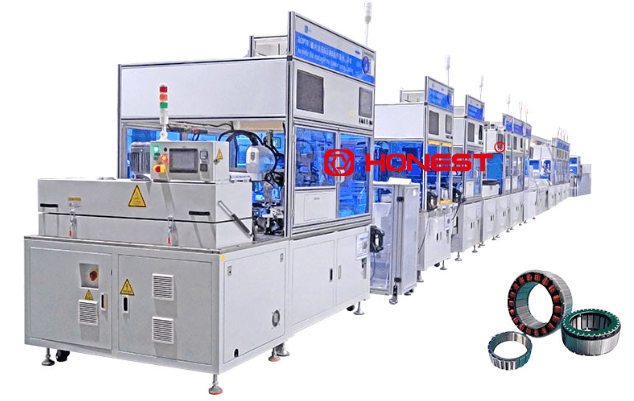The rapid rise of humanoid robots is reshaping industries worldwide, from service sectors to advanced manufacturing and healthcare. As global demand for intelligent, agile, and human-like robots accelerates, the technological foundation behind their smooth, precise movements becomes critical—this foundation lies in the performance of their motors. Specifically, high-torque, compact, and highly reliable motors power every joint and motion of a humanoid robot.
However, the development and scaling of humanoid robots are not just dependent on motor design, but also on efficient, automated electric motor winding machine. In today's competitive landscape, manufacturers must ensure precision, consistency, and scalability in motor assembly to meet growing market needs and evolving technical standards.

The motor is the core component of humanoid robots and directly determines the robot's motion performance. The era of humanoid robots has arrived. From Boston Dynamics' Atlas to Tesla's Optimus, humanoid robots are no longer just concepts, but practical smart partners that are about to enter the lives of the public.
From industrial production to home services, from medical rehabilitation to education and entertainment, the application areas of humanoid robots are constantly expanding, and their technology is also continuously innovating.
The development of humanoid robots not only depends on advanced algorithms and artificial intelligence technologies, but also on high-performance hardware support. Among them, the motor, as one of the core components of humanoid robots, plays a vital role. The performance of the motor directly affects the performance of humanoid robots in terms of motion ability, flexibility, stability and energy efficiency.
The Role of Motors in Humanoid Robots
Motion Control
Humanoid robots need to simulate human movements, such as walking, running, grabbing objects, etc. Motors play a role similar to human muscles in this process. Through precise control, robots can achieve various complex movements.
For example, installing motors at the joints of the robot can drive the flexion, extension, rotation and other movements of the joints, thereby achieving arm swings and leg steps. By coordinating the movement of multiple motors, humanoid robots can complete difficult tasks such as dancing and climbing.
Power Transmission
When performing some tasks, humanoid robots need to exert a certain amount of force, such as picking up heavy objects and pushing open doors. Motors can convert electrical energy into mechanical energy to provide the robot with the required force.
Motors of different specifications can meet scenarios with different force requirements. For example, installing high-power motors at the arm joints of the robot can enable the arm to have greater grasping and lifting forces, while installing low-power motors at the finger joints can achieve fine grasping movements.
Posture Adjustment
Humanoid robots constantly adjust their postures to maintain balance and stability. The motor can respond quickly and make adjustments based on the information fed back by the sensor.
For example, when the robot encounters uneven ground while walking, the motor can drive the joints to make fine adjustments to keep the robot balanced and avoid falling. In addition, when the robot turns or changes direction quickly, the motor can also quickly adjust the joint angle to ensure the coordination of the body posture.
Energy Conversion and Utilization
The motor also undertakes the task of energy conversion in humanoid robots, efficiently converting the electrical energy provided by the battery into mechanical energy to drive the robot to move. At the same time, through reasonable motor control strategies, energy recovery and reuse can be achieved to improve the energy efficiency of the robot.
For example, when the robot goes downhill or brakes, the motor can enter the power generation state, convert part of the mechanical energy into electrical energy, store it in the battery, and extend the robot's battery life.
Common Motor Types used in Humanoid Robots
DC Motor
DC motor is a type of motor widely used in humanoid robots. It has the characteristics of simple structure, convenient control and good speed regulation performance. The working principle of DC motor is based on the force of current-carrying conductor in magnetic field. By changing the magnitude and direction of current, the speed and rotation direction of the motor can be controlled.
In humanoid robots, DC motors are often used in joint drive, limb movement and other scenarios.
Advantages: The control of DC motor is relatively simple, and the speed and torque can be controlled by adjusting the input voltage or current. In addition, DC motor has high efficiency and can output large power at medium and high speeds, which is suitable for joints that require large power output.
Disadvantages: DC motors need brushes to conduct electricity, and brushes are easy to wear when rotating at high speeds and need regular maintenance. At the same time, the commutator of DC motors also has a certain life limit, and may fail after long-term use. In addition, when DC motors run at low speeds, torque pulsation is prone to occur, affecting the smoothness of movement.
Stepper Motor
Stepper motor is a motor that converts electrical pulse signals into angular displacement. It has the advantages of high control accuracy, rapid start and stop, and high reliability. The working principle of the stepper motor is based on electromagnetic induction. By energizing the stator winding in sequence, a rotating magnetic field is generated, which drives the rotor to rotate step by step.

In humanoid robots, stepper motors are often used in joints that require high-precision position control, such as fine movement control of finger joints.
Advantages: The biggest feature of stepper motors is high control accuracy and the ability to achieve precise angle positioning. Through reasonable pulse control, the rotor of the stepper motor can be rotated to the specified angle position with small error. In addition, the stepper motor has a fast response speed when starting and stopping, and can reach a stable speed in a short time, which is suitable for joint control scenarios that require fast response.
Disadvantages: The efficiency of the stepper motor is relatively low, and it is easy to lose step when running at high speed, that is, the rotor cannot keep up with the changes in the stator magnetic field, causing the motor to lose control. In addition, the torque characteristics of the stepper motor are better at low speed, but the torque will decrease at high speed, which limits its application in high-speed and high-torque scenarios. At the same time, the stepper motor will generate certain noise and vibration during operation, affecting the smooth operation of the robot.
Brushless DC motor
Brushless DC motor is a new type of motor that combines the advantages of DC motor and AC motor. The working principle of brushless DC motor is to realize the rotation of the motor through electronic commutator, without brushes and commutator, thus improving the reliability and life of the motor.
In humanoid robots, brushless DC motors are often used for joint drives that require high efficiency, high power density and long life.
Advantages: Brushless DC motors have high efficiency and power density, can output large power with small volume and weight, and are suitable for humanoid robot joints that require space and weight. Due to the absence of brushes and commutators, brushless DC motors have a long life and low maintenance costs. In addition, brushless DC motors have low operating noise, which can improve the smoothness and quietness of robot operation.
Disadvantages: The control of brushless DC motors is relatively complex, and special electronic commutators and control algorithms are required, which increases the complexity and cost of the system. In addition, when brushless DC motors are running at low speeds, the torque pulsation problem still exists, and special control strategies are needed to reduce its impact.
Servo Motor
A servo motor is a motor system that can accurately control position, speed and torque. It usually consists of a motor body, a reducer and a control system, and can achieve high-precision motion control. The working principle of a servo motor is to feed back the actual position and speed information of the motor to the control system through a feedback device (such as an encoder, a potentiometer, etc.). The control system compares and adjusts according to the set target value and feedback value, thereby achieving precise control of the motor.
In humanoid robots, servo motors are widely used in joint drives and are currently a more common type of motor.
Advantages: The servo motor has high control accuracy and can achieve precise position, speed and torque control, meeting the high-precision requirements of humanoid robots for joint motion. At the same time, the servo motor has a large output torque, which can meet the robot's demand for power during motion. In addition, the servo motor has good stability and reliability, and can maintain stable operation in complex motion environments.
Disadvantages: The cost of the servo motor system is high, including the cost of the motor body, reducer and control system. In addition, the servo motor has a relatively complex structure, large size and weight, and may be restricted for some robot joints that have strict requirements on space and weight. At the same time, when the servo motor runs at high speed, due to the delay of feedback control, certain oscillations may occur, which needs to be improved by optimizing the control algorithm.
Development Trends of Humanoid Robot Motor Technology
Miniaturization and Lightweighting
With the continuous expansion of humanoid robot application scenarios, the demand for miniaturization and lightweighting of motors is becoming increasingly urgent.
On the one hand, miniaturized and lightweight motors can reduce the volume and weight of robot joints, improve the flexibility and mobility of robots, and enable them to perform tasks in small spaces or complex environments.

On the other hand, this also puts higher requirements on the design and manufacturing process of motors. It is necessary to achieve the miniaturization and lightweighting of motors by optimizing motor structures, adopting new materials and advanced manufacturing technologies without reducing motor performance.
Efficiency and Energy Saving
Improving the efficiency and energy-saving performance of motors is an important direction for the development of humanoid robot motor technology. Efficient motors can output more mechanical energy under the same energy input, extend the robot's endurance, and reduce energy consumption costs.
The efficiency of motors can be effectively improved by improving the electromagnetic design of motors, optimizing winding structures, using high-performance magnetic materials and advanced heat dissipation technologies. In addition, combined with intelligent control strategies, such as energy recovery technology and variable frequency speed regulation technology, the energy-saving operation of motor systems can be further realized.
Intelligence and Integration
Future intelligent humanoid robots will have stronger autonomy and adaptability. As one of their key components, motors also need to develop in the direction of intelligence and integration.
Intelligent motors will have functions such as self-diagnosis, fault warning, and automatic speed and torque regulation, and can monitor their own operating status in real-time, and automatically adjust operating parameters according to environmental changes and task requirements to improve the reliability and efficiency of the system. At the same time, the integrated design of motors and reducers, controllers, sensors and other components will become a trend. By integrating multiple components into one, the volume and weight of the system can be reduced, and the compactness and coordination of the system can be improved.
Research and Development of New High-Performance Motors
In order to meet the higher requirements of humanoid robots for motor performance, researchers are actively exploring and developing new motor technologies. For example, new motors such as coreless motors, reluctance motors, and superconducting motors have performance advantages such as higher power density, efficiency, and torque density, and have broad application prospects in the field of humanoid robots.
Since the traditional iron core structure is removed, the coreless motor reduces the size and weight of the motor, while reducing iron loss, improving the efficiency and torque density of the motor, and is suitable for robot joints with strict space and weight restrictions.
The reluctance motor uses the principle of minimum magnetic resistance to achieve motor rotation by changing the magnetic circuit structure of the stator and rotor. It has the advantages of simple structure, low cost, and high efficiency, and is expected to be widely used in humanoid robots.
The superconducting motor uses the zero resistance characteristics of superconducting materials to achieve extremely high current density and magnetic field strength, thereby greatly improving the power density and efficiency of the motor. However, due to the current cost and refrigeration requirements of superconducting technology, its application in humanoid robots is still in the exploratory stage.
Challenges and Prospects of Humanoid Robot Motor Technology
Although humanoid robot motor technology has made significant progress in recent years, it still faces some challenges.
First, how to maintain or even improve the performance of motors while miniaturizing and lightweighting is a problem that needs to be solved urgently. This requires in-depth research and innovation in motor design, material selection and manufacturing process.
Second, the reliability and life of motors are crucial to the long-term stable operation of humanoid robots. Especially in complex motion environments and frequent start-stop operations, how to improve the reliability and wear resistance of motors is a difficult problem that needs to be further overcome.
In addition, with the improvement of the intelligence level of humanoid robots, higher requirements are also put forward for the real-time, accuracy and intelligence level of motor control systems. It is necessary to continuously optimize the control algorithm and drive circuit to achieve seamless coordination between the motor and the overall robot system.
In the future, humanoid robot motor technology will continue to make breakthroughs driven by the cross-disciplinary integration.
Through in-depth cooperation with materials science, micro-nano manufacturing technology, artificial intelligence and other fields, it is expected to develop new motor products with better performance and more powerful functions. At the same time, with the maturity of technology and the reduction of costs, humanoid robots will be widely used in more fields, bringing new opportunities and changes to the development of human society.
Humanoid Robot Motor Production Line
HONEST Automation's humanoid robot motor production line features a modular and highly flexible design, ensuring seamless compatibility with multiple motor models. Switching between models is effortless—simply load the corresponding program and replace the fixture, enabling fast changeovers and maximizing production efficiency. HONEST Automation also provides fully customized, non-standard solutions tailored to meet your specific manufacturing needs, including humanoid robot motor assembly lines, actuator motor stator assembly equipment, frameless torque motor assembly systems, robot linear actuator assembly, and other key intelligent production equipment.

With proven, successful equipment cases already delivered to leading humanoid robot manufacturers, HONEST Automation is your trusted partner for delivering high-precision, scalable, and reliable motor assembly solutions.







